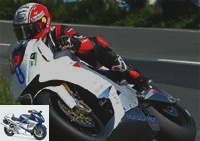TT 2013: MotoCzysz rings the (re) charge in electric motorcycles

While waiting for the Superbike final of the Tourist Trophy – for which Michael Dunlop starts as favorite after winning the first SBK round, the Superstock and the two SSP rounds – the spectators gathered around the Isle of Man road circuit were able to attend the fifth edition of the TT Zero, a race between electric sports motorcycles.
While waiting for the Superbike final of the Tourist Trophy – for which Michael Dunlop started as favorite after winning the -, spectators gathered around the Isle of Man road circuit were able to attend the fifth edition of the TT Zero, a race between motorcycles electric sports.
Like last year, it was the forty-something Michael Rutter who won on his MotoCzysz E1pc, a motorcycle that would exceed 200 hp and develop 220 Nm of torque built in Oregon (read in particular). And like last year, Rutter won ahead of the Shinden Ni developed by Mugen (a Japanese trainer closely linked with Honda) and driven by TT star John McGuiness.
What changes compared to 2012, however, is the pace at which these "e-superbikes" completed the 60 km of the famous road layout: Rutter turned at an average 109.675 mph (around 176.5 km / h), or 5 good miles faster than in 2012 (104.1 mph, or just over 167 km / h).
Second, John McGuinesse is no exception and significantly improves his performance by exceeding 109 mph per lap on his Mugen for the first time. The "Morecambe Missile" maintained a nice 109.527 average, against 102.215 mph in 2012. Behind, the gap widens markedly since the third, Robert Barber, did not exceed 90 miles (a small 145 km / h) of average on his RW-2 engaged by the University of Ohio.
TT Zero 2013: the results
In the end, what to conclude from this fifth edition of the TT Zero? First of all, as the electric racing motorcycles progress, at least the front ones: Rutter has averaged almost 10 km / h per lap on a circuit that has 350 turns, most of which are super-fast..
Even if these "battery-powered sports cars" are still far from the rates reached by the fastest thermal motorcycles – the best exceed 200 km / h on average! -, the gap narrows and becomes less ridiculous.
For the anecdote, some spectators had indeed found the spectacle so soporific during the first editions of the TT Zero that many packed their bags after a few minutes of "racing" !
There remains a major difference between “electric” and “thermal”: battery-powered motorcycles only cover one lap, against six (with two refueling) for gas-filled Superbikes. In "TiTi" as in our streets, the main obstacle to the development of electric motorization is not necessarily pure performance, but rather autonomy….
Related articles
-
Victory Motorcycles enters two electric motorcycles in the Tourist Trophy The American customs builder Victory Motorcycles will enter two electric…
-
Tourist Trophy – TT 2012: the wall of 100 mph crossed on an electric motorcycle! –
TT 2012: the wall of 100 mph crossed on an electric motorcycle ! The Isle of Man hosted the Tourist Trophy race for electric motorcycles on Wednesday….
-
Tourist Trophy – The FIM supports the participation of electric motorcycles in the Tourist Trophy –
The FIM supports the participation of electric motorcycles in the Tourist Trophy In order to support the development of clean vehicles, the FIM has just…
-
Tourist Trophy: John McGuinness (Mugen) wins the TT Zero Challenge for electric motorcycles Like last year, John McGuinness this morning won the Tourist…
-
Michael Dunlop wants to win at the Tourist Trophy 2019 … and at Pikes Peak ! Devastated last summer by the disappearance of his brother William,…
-
Tourist Trophy – TT 2013: Michael Dunlop wins in Superbike –
TT 2013: Michael Dunlop wins in Superbike New Honda TT Legends rider Michael Dunlop won the first Superbike race of the 2013 Tourist Trophy. The late and…
-
Tourist Trophy – Tourist Trophy: McGuinness wins the Senior TT 2013 –
Tourist Trophy: McGuinness wins the Senior TT 2013 John McGuinness claimed his 20th Tourist Trophy victory in the 2013 Senior TT Final on Friday….
-
Tourist Trophy – Sarolea lines up its new electric SP7 for the Tourist Trophy – Occasions SAROLEA
Sarolea lines up its new electric SP7 for the Tourist Trophy Sarolea, the historic Belgian manufacturer, will line up his new electric Superbike SP7 2015…
-
Tourist Trophy – Tourist Trophy 2014: Michael Dunlop on a BMW S 1000 RR – Used BMW
Tourist Trophy 2014: Michael Dunlop in a BMW S 1000 RR BMW has just announced that Michael Dunlop, nephew of Joey and seven-time winner of the Tourist…
-
Tourist Trophy 2017: a tour of the Isle of Man on the BMW HP4 Race in on-board video Hold on to the keyboard for a full tour of the Isle of Man road…